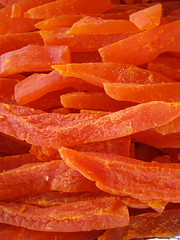No matter how you feel about Southern California, there's no changing the fact that some really great things come from this place. One of my favorites is Trader Joe's.
I was lucky enough to grow up less than 5 minutes from the Redlands Trader Joe's. Since the supermarket lockout of 2003, I've pretty much abandoned the traditional grocers in favor of the farmer's market, Henry's, and TJ's.
I'm thinking my next career should be as a member of the tasting panel. That's a job I could really love.
For Trader Joe's, a New York Taste Test
By JULIA MOSKIN Monrovia, Calif.
IN an industrial park somewhere in Los Angeles, the pieces of the puzzle come together. One crew, using rakes, turns 525 pounds of newly roasted peanuts trucked in from Texas. Another adds a heavy shower of dried whole chilies, lemon grass fibers, curry leaves and cane sugar imported from a producer in Thailand whose identity is a closely kept secret.
"No one except us knows all the parts of the operation," said Matt Sloan, vice president for merchandising for the Trader Joe's food stores, whose popularity took off in California in the 1970's and whose first store in New York City is opening on March 17. "In that way it's like a conspiracy." Long before Trader Joe's went national, its inexpensive but unusual products — things like wild blueberry juice, Sicilian extra-virgin olive oil and frozen chicken-lemon grass spring rolls — inspired an intense following among American food lovers, rarely seen in the aisles of a supermarket.
The stores are small, the selection is uneven and the corporate culture can be described as dorky. But because its products are often not available anywhere else; because they mysteriously appear, disappear, then reappear on the shelves; or perhaps simply because they often taste very, very good, Trader Joe's has become tremendously popular among Americans who like to be entertained and educated by what they eat, as well as nourished by it.
To protect its house-brand products, the company is notoriously secretive. But it opened slightly to this reporter recently, for the first time allowing an outsider into the daily critique conducted by the company's best-trained palates, a group known as "the tasting panel."
"The tasting panel is what takes us from having good products to having addictive products," said Doug Rauch, the president.
Like Trader Joe's Thai Lime & Chili Peanuts, for example: rich, spicy, fragrant, sweet and not quite like anything else on the mass market. They represent the end of a long process of travel, research, argument and experimentation. "You can drive yourself crazy in this job, like a cat chasing its tail, and sometimes you never get there," said Lori Latta, who buys dried fruit and nuts for the company and has been on the tasting panel for 20 years.
More than a buyer, Ms. Latta adds in the skills of chef, advocate, food scientist and nutritionist. Her job, and those of the 14 other "category leaders," is to perpetually travel the world visiting all kinds of food businesses — restaurants, farmers' markets, artisanal pasta makers, street stalls and supermarkets — and then translate their finds to the stores. When a category leader was served an ideal tiramisù at a small restaurant on the Amalfi coast of Italy, he spent months working with the chef on a version that could be mass-produced, frozen, exported to the United States and sold for $6.99 in freezer cases from San Diego to Boston. But first it had to pass the tasting panel.
In the case of the peanuts, "I tasted that snack in a Thai airport, but it was stale and too salty and full of MSG," Ms. Latta said. With a California manufacturer, she recreated it, omitting artificial additives and using American peanuts (to avoid high import tariffs) and Thai seasonings (for authentic flavor). She then repeatedly presented it to the tasting panel, adjusting flavors until the whole group agreed that the proper balance of salt, spice, citrus and heat had been achieved.
The panel is sufficiently focused to spend long minutes discussing, for example, the different effects of fine sea salt, coarse sea salt, coarse kosher salt and medium kosher salt on roasted walnuts. Getting the panel's approval can take months, even years.
Once approved, new products line up next to the popular peanut-butter-stuffed pretzels, chocolate-covered espresso beans and green chili tamales, all of them additive-free, all-natural and capable of driving grown men to unnatural acts.
"Before we got our Trader Joe's I used to drive up to Chicago every couple of months to stock up on those pretzels," said Kevin Messina, a lawyer in Creve Coeur, Mo., near St. Louis. "It's about five hours each way, but hey, it's a straight shot."
The products that make it through but do not find a loyal customer base meet an implacable fate. "It's like at General Electric under Jack Welch," said Mr. Sloan, the vice president for merchandising. "The bottom 10 percent is always being rotated out. It's painful but necessary, because it ensures that we always have new products for our customers to get interested in."
There is nothing quite like the chain anywhere else on the American food landscape. "Trader Joe's is radically different in many ways from other food retailers," said Stephen Dowdell, editor in chief of Progressive Grocer magazine. "The stores are small, they don't rely on national brands, you can't do price comparisons and they definitely don't offer one-stop shopping. But every product has a story."
The Polynesian-themed chain was established by Joe Coulombe in Pasadena, Calif., in the 1960's, in an attempt to rescue his convenience stores after 7-Eleven came to town. "We decided to go in the other direction — to appeal to people who are well-educated, well-traveled and underpaid," Mr. Coulombe said. (He sold his final interest in the company in 1989, but many of his innovations are still in place.)
In the 1970's, he said, after the stores stopped selling things like Twinkies, magazines and batteries and focused on food and wine, the business took off. "For years, we were the country's largest importer of Dijon mustard. Of capers. Of arborio rice. Of everything like that you can think of."
The chain's expansion is of recent vintage: the first store outside California opened in 1993. Today, each of the 250 stores still carries only about 3,000 items (a large supermarket will stock 55,000 or more), in proportions that invert the industry norm: a tiny selection of canned soup, for example, but case after case of French ice cream confections and frozen Indian entrees. About 80 percent of the items carry the Trader Joe's label, many imported from small producers in Europe and Asia, and all free of artificial colors, preservatives, flavors and MSG.
"With those parameters, some things — ramen noodles come to mind — are almost impossible for us to make," Mr. Sloan said. "So generally we just don't have them."
Fans of the chain find such quirks endearing. All employees wear Hawaiian shirts at work, whether they are shelvers or the chief executive. "It helps us keep a sense of humor about what we do," said Mr. Sloan, who, like many senior staff members, began working for the company as a college student — that was in 1993 — and never left.
All this has helped build the Trader Joe's mystique into a full-scale food cult. It will soon be clear whether the cult will take hold in New York City, where scores of local retailers specialize in top-quality imported house-brand products (among them Zabar's, Sahadi's, or Agata & Valentina).
The chain has a strong health food streak, making the new Manhattan store competitive with the much larger Whole Foods just down the block. A stunning amount of shelf space is devoted to trail mixes (dark antioxidant-rich berries are hot, as are raw nuts rich in omega-3's) and energy bars like LäraBar and Clif, which the chain discounts deeply. "You should have seen it a few years ago," Ms. Latta said. "The bars almost took over the store."
Trader Joe's has also guided its customers into the world of prepared food and precut vegetables — what Mr. Rauch, the president, calls "speed scratch" cooking. "Trader Joe's customers are people who really care about cooking," he said, "but like everyone else in America, they don't feel like they have time to chop all the vegetables, cook the chicken and make the dessert — but they want to be in the kitchen." The stores stock lots of things like precut butternut squash and beets, "simmer sauces" that make quick stews, and marinated salmon fillets packaged with fresh herbs in oven-ready cooking bags. "We are very careful about marinades," Mr. Sloan said solemnly. "Dill can be very polarizing."
About 40 percent of salad greens in American supermarkets are sold already separated, washed and bagged. At Trader Joe's, the proportion is close to 100 percent.
"Who buys head lettuce anymore?" Ms. Latta said, surveying a produce case stuffed with bags of organic baby arugula, herb salad and sugar snap peas at the original Trader Joe's, on Arroyo Parkway in Pasadena. There was not a vegetable in sight that was not packed in plastic. "The whole food business is now trying to figure out how to keep people cooking," Mr. Rauch said. "We pull in things from all over the world that work for our customers."
One February afternoon at the headquarters in Monrovia, near Pasadena (yes, even the receptionists wear Hawaiian shirts), the tasting panel members, most well into their 40's or older, crowded cheerfully into the test kitchen. (This reporter was allowed in on condition that individual members — many of whom negotiate with vendors for changes in products — not be quoted by name on the opinions they expressed.) The pasta buyer had boiled up six different Italian brands of whole-grain pasta and tossed them in plain olive oil.
The group fell silent and began chewing intently. Immediately, comments flew. "Interesting nutty flavors on No. 1." ... "This one has a cardboardy texture at the end." ... "What about the omega-3's on this one?" Eventually, a favorite was determined by a show of hands and a plan sketched for the step ahead: persuading the supplier to make refinements and solve problems.
Next, aged goat cheeses. Then truffled cheeses. ("Like dirty socks." ... "I think people want to see those black flecks." ... "I worry that we're just too far ahead of the curve with these.") Toasted walnuts, then granola clusters. ("How are these not cookies?" the house nutritionist asked.) And finally a new category: trail-mix-based cereals. The group poured milk and chewed. "I am not happy to get a whole almond in my bowl of cereal," one said forcefully.
That kind of passionate, focused attention to food is clearly sensed by Trader Joe's customers. "This sounds crazy, but you feel like the company likes food even more than they like money," said Marcy Benfiglio, who lives near the branch in Larchmont, N.Y. "You don't feel that at the supermarket."




















